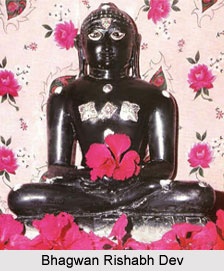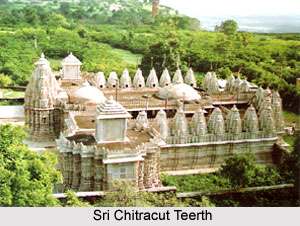 Shri Chitracut Teerth located in Rajasthan is a Jain pilgrimage centre. The Jain teerth is situated in a fort that is three and a half miles long and one mile broad level surface. It is almost 550 meters above the sea shore. The temple is dedicated to Bhagwan Rishabh Dev, the first Jain Tirthankara.
Shri Chitracut Teerth located in Rajasthan is a Jain pilgrimage centre. The Jain teerth is situated in a fort that is three and a half miles long and one mile broad level surface. It is almost 550 meters above the sea shore. The temple is dedicated to Bhagwan Rishabh Dev, the first Jain Tirthankara.
History of Shri Chitracut Teerth
According to history Shri Chitracut Teerth dates back to the ancient period. As per reference the teerth kshetra was earlier known as Madhyamika. Apart from the main temple many other temples are located here. The beautiful temple of Lord Mahavira was constructed in the year 1167 of the Vikram Samvat Era. Another temple dedicated to Lord Parshvanatha was built in the year 1322 of the Vikram Samvat Era. During the reign of King Mokal several attractive Jain temple have been built here by the King`s advisor. The striking fort in which the temple can be seen was built by the King Chitranand of the Maurya Empire. It is thus known as Chitrakut. The teerth kshetra has been the land of great religious leaders. It is the birthplace of Acharya Haribhadrasurishvarji. The teerth finds its mention in the Tirthamala composed between the years 1563 and 1566 of the Vikram Samvat Era. It states that there were 32 striking temples of different gachchhas located here. The seven storied Jain Kirtistambh was also among them that was constructed in the fourteenth century. It was built in memory of Bhagwan Rishabh Dev. Presently there are six temples on the fort. The largest and the most important among them is the temple of Bhagwan Rishabh Dev. It has fifty-two devkulikas. The place where the temple is located is known as `Sattavish Devri`. It means that in the past, there were twenty-seven temples here. Many notable kings have also been born here and are said to have made remarkable achievements. Several Jain advisors also resided in the courts of these kings. The place of Bhamasha, the great donor and Maharana Pratap`s treasurer, is also here. An inscription has been found that states King Kumarpal had chartered Chitrakut with seven hundred villages to a potter, Alik as he had once protected him.
The idol of Bhagwan Rishabh Dev is believed to possess miraculous powers. Thousands of Jains and non Jains from far off places visit the temple to offer their prayers. It is believed that if prayed with all devotion the Lord fulfils the wishes of the pilgrims.
Temple of Shri Chitracut Teerth
 According to history Shri Chitracut Teerth houses the idol of Bhagwan Rishabh Dev. The Swetambara temple has been magnificently decorated with intricate artistic designs. The creative temple work boast about the skills of the craftsmen. The walls and pillars of the temple are adorned with specimens of ancient art and paintings. The idol of the Lord is 35 cm in height and is black in colour. It is seated in a padmasana posture. The idol has been beautifully carved from a single stone and looks very appealing. The smiling face of the Lord looks very calm and serene. Apart from this there are five other attractive temples located in the fort. In Rampol Street of the village on the fort, there are temples of Lord Mahavira and of Lord Shantinath in the same compound. These have been richly decorated with attractive designs. It is known as the Shrungal Choki. There is a beautiful stepped pond known as Gaumukhi Kund. It has a temple that is dedicated to Lord Parshvanatha. The temple is adorned with rich sculptural work. Besides these the temple of Mirabai and Samidheshva located here are also eye catching and worth seeing. A Smrutimandir of Haribhadrasurishvarji can also be seen below the fort near the gateway leading towards the village.
According to history Shri Chitracut Teerth houses the idol of Bhagwan Rishabh Dev. The Swetambara temple has been magnificently decorated with intricate artistic designs. The creative temple work boast about the skills of the craftsmen. The walls and pillars of the temple are adorned with specimens of ancient art and paintings. The idol of the Lord is 35 cm in height and is black in colour. It is seated in a padmasana posture. The idol has been beautifully carved from a single stone and looks very appealing. The smiling face of the Lord looks very calm and serene. Apart from this there are five other attractive temples located in the fort. In Rampol Street of the village on the fort, there are temples of Lord Mahavira and of Lord Shantinath in the same compound. These have been richly decorated with attractive designs. It is known as the Shrungal Choki. There is a beautiful stepped pond known as Gaumukhi Kund. It has a temple that is dedicated to Lord Parshvanatha. The temple is adorned with rich sculptural work. Besides these the temple of Mirabai and Samidheshva located here are also eye catching and worth seeing. A Smrutimandir of Haribhadrasurishvarji can also be seen below the fort near the gateway leading towards the village.
The Temple of Sri Chitracut Teerth organises many annual gatherings and functions. There are provisions for dharamshalas or rest houses for the pilgrims. These are well equipped with all modern facilities. There are also Upashrays, an Ayambilshala and a Jnanabhandar. The teerth is situated amidst beautiful natural surroundings and is enclosed by scenic beauty. The natural environment mesmerises and fascinates the pilgrims. The calm and tranquil atmosphere and the surrounding greenery make it a suitable place for religious activities. The kshetra is well connected to road, rail and air. Taxi services and bus services are easily available here. The nearest railway station is located at Chitodgadh that is at a distance of 7 kilometers from the temple.




















